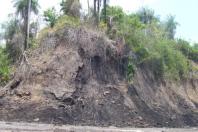Notes on Fracking, Oil Shale, Tight Oil and this website

Not what this web site is about.
"Fracking," or hydraulic fracturing, is sometimes incorrectly referred to as oil shale extraction. In fact, fracking is the process of removing oil which is in a liquid state, but is trapped by shale.
This website does not discuss fracking.
The kind of oil shale which is discussed on this web site is more accurately known as "kerogen shale." Similar to bitumen, kerogen is not oil, but rather a proto-oil that given millions of years could become crude. Unlike "fracked" oil, it is not liquid, but is actually fused within the shale. Like bitumen/tar sands, kerogen needs energy-intensive processing before it reaches a state similar to heavy crude oil. Oil shale kerogen starts out in a solid form and needs to be artificially separated from rock through mechanical processes which use large amounts of energy -- usually natural gas -- and water.
When it is mined, the kerogen shale is pulverized and processed in a fashion similar to Canadian conveyor belt upgraders. The shale rock must be heated for an exceptionally long time, before kerogen 'bleeds' out of the rock. In-situ kerogen shale operations use steam and heat to separate the kerogen from the shale in the ground, similar to large in-situ operations for bitumen extraction, except that the time frame for heating shale in the ground is measured in multiple months. The heating is carried out via electrical heating coils or traditional steam methods associated with bitumen and other extra-heavy oil desposits.
Companies eyeing large oil shale deposits from Jordan to China to Australia have all spoken of their desire to emulate Canada's story while borrowing patented processes developed in the Canadian tar sands as well as Estonian, Chinese and Brazilian oil shale. For this reason, this website only refers to kerogen-infused shale rock when referring to oil shale, and not shale that can be 'fracked' to release liquid crude.
Recently, people in the oil and gas industry have begun to refer to oil released via fracking as “tight oil.” This web site follows the same convention.


